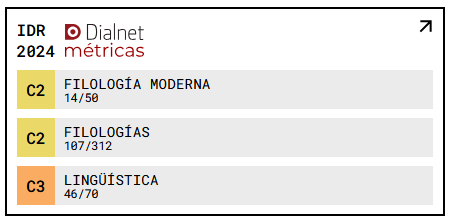The deviant body in neo-Victorian literature: a somatechnical reading of the freak in Rosie Garland’s "The palace of curiosities" (2013)
DOI:
https://doi.org/10.18172/jes.2819Keywords:
Neo-Victorianism, body, Freak Show, somatechnics, stare embodied subjectivity, stare.Abstract
The contemporary fascination with historical, social and literary representations of the deviant body calls for new understandings of corporeality that question the body as a purely biological entity, and invites readings of corporeality as culturally inflected. The present article explores neo-Victorian enfreakment through the lens of “somatechnics” reading “[e]mbodiment as the incarnation or materialisation of historically and culturally specific discourses and practises” (Sullivan and Murray 2014: 3). I will apply the concept of somatechnics to (neo-)Victorian enfreakment practises drawing on scholars as Bordo (1993), Grosz (1994), Sullivan and Murray (2014) who, among others, have challenged the binary split between the mind and body, and argued for the social construction of embodied subjectivities. Although the body’s physical materiality is irreducible, the body is always invested, shaped and transformed by external forces, or “technologies of power” as denominated by Foucault (2003a). I seek to address the human exhibit in Rosie Garland’s The Palace of Curiosities (2013) to examine neo-Victorian reinventions of the divergent body. With this objective in mind, I will analyse how the neo-Victorian mode interlocks the Victorian freak-show discourse with the reader perspective to bring subjective responses to corporeality, humanity and normativity to the forefront, and in doing so, turns an exploitative space as the freak show into a site of self-reliance, self-expression and even fulfilment.Downloads
References
Adams, R. 2001. Sideshow U.S.A.: Freaks and the American Cultural Imagination. Chicago: Chicago UP.
Balsamo, A. 1999. “Forms of Technological Embodiment”. Reading the Body in Contemporary Culture. Feminist Theory and the Body: A Reader. Eds. J. Price and M. Shildrick. Edinburgh: Edinburgh UP. 278-289.
Boehm-Schnitker, N. and S. Gruss. 2011. “Introduction: Spectacles and Things – Visual and Material Culture and/in Neo-Victorianism”. Neo-Victorian Studies 4.2: 1-23.
Bogdan, R. 1990 (1988). Freak Show: Presenting Human Oddities for Amusement and Profit. Chicago: Chicago UP.
Bogdan, R. 1996. “The Social Construction of Freaks”. Freakery: Cultural Spectacles of the Extraordinary Body. Ed. R. Garland-Thomson. London and New York: New York UP. 23-37.
Bordo, S. 1993. Unbearable Weight: Feminism, Western Culture, and the Body. Los Angeles: California UP.
Carlson, Stacy. 2011. Among the Wonderful. Hanover, NH: Steerforth.
Chase-Riboud, B. 2003. The Hottentot Venus: A Novel. New York: Anchor Books. Craton, L. 2009. The Victorian Freak Show: The Significance of Disability and Physical Differences in 19th-Century Fiction. Amherst (NY): Cambria.
Davies, H. 2012. Gender and Ventriloquism in Victorian and Neo-Victorian Fiction: Passionate Puppets. Basingstoke: Palgrave Macmillan.
Davis, J. L. 1995. Enforcing Normalcy: Disability, Deafness and the Body. London: Verso.
Duncan, N. 1996. “Renegotiating Gender and Sexuality in Public and Private Spaces”. Bodyspace: Destabilizing Geographies of Gender and Sexuality. Ed. N. Duncan. London and New York: Routledge. 127-145.
Flanders, J. 2013. “The Palace of Curiosities: This Tale from the Victorian Freak Show Narrowly Avoids Cliché”, by R. Garland. The Guardian 6 April. <http://www.theguardian.com/books/2013/apr/06/palace-of-curiosities- review>. (Accessed 5 March 2015).
Foucalt, M. 2003a (1999). Abnormal: Lectures at the College de France 1974-1975. Eds. V. Marchetti and A. Salomoni. Trans. G. Burchell. London: Verso.
Foucault, M. 2003b (1997). Society Must Be Defended: Lectures at the College de France, 1975-76. Eds. V. Marchetti and A. Fontana. Trans. D. Macey. New York: Picador.
Garland, R. 2013. The Palace of Curiosities. London: Harper Collins. Garland-Thomson, R. 2009. Staring: How We Look. Oxford: Oxford UP.
Gatens, M. 1996. Imaginary Bodies: Ethics, Power and Corporeality. London and New York: Routledge.
Gerber, D. 1996. “The ‘Careers’ of People Exhibited in Freak Shows: The Problem of Volition and Valorization”. Freakery: Cultural Spectacles of the Extraordinary Body. Ed. R. Garland-Thomson. London and New York: New York UP. 38-54.
Grosz, E. 1994. Volatile Bodies: Towards a Corporeal Feminism. Bloomington: Indian UP.
Gylseth, C. H. and L. O. Toverud. 2003 (2001). Julia Pastrana: The Tragic Story of the Victorian Ape Woman. Trans. D. Tumasonis. Sparkford: J. H. Haynes.
Heilmann, A. and M. Llewellyn. 2010. Neo-Victorianism: The Victorians in the Twenty-First Century, 1999-2009. Basingstoke: Palgrave Macmillan.
Jaggar, A. M. and S. Bordo. 1992. Gender/Body/Knowledge: Feminist Reconstructions of Being and Knowing. New Brunswick: Rutgers UP.
Katsouraki, E. and D. Watt. 2013. “Bodies of Failure”. Somatechnics 3.1: 1-8.
Kérchy, A. and A Zittlau. 2012. Introduction. Exploring the Cultural History of the Continental European Freak Shows and “Enfreakmenet”. Newcastle upon Tyne: Cambridge Scholars. 2-19.
Mulvey, L. 1989. Visual and Other Pleasures. Basingstoke: Palgrave Macmillan.
Pettersson, L. 2016. “‘Definitely an Author to Watch’: Rosie Garland on the (Neo-)Victorian Freak”. Neo-Victorian Studies 8.2: 200-223.
Shildrick, M. 2002. Embodying the Monster: Encounters with the Vulnerable Self. London: Sage.
Stern, R. 2008. “Our Bear Women, Our Selves: Affiliating with Julia Pastrana”. Victorian Freaks: The Social Context of Freakery in Britain. Eds. M. Tromp and K. Valerius. Columbus: Ohio State UP. 200-234.
Sullivan, J. 2012 (2011). Little People: A Novel. London: Allen and Unwin.
Sullivan, N. and S. Murray. 2014. Introduction. Somatechnics: Queering the Technologisation of the Body. Eds. N. Sullivan and S. Murray. Farnham: Ashgate. 1-12.
Tromp, M. and K. Valerius. 2008. “Towards Situating the Victorian Freak”. Victorian Freaks: The Social Context of Freakery in Britain. Eds. M. Tromp and K. Valerius. Columbus: Ohio State UP. 1-18.
Weiss, G. 1999. Body Images: Embodiment as Intercorporeality. London and New York: Routledge.
Williams, S. J. and G. Bendelow. 1998. The Lived Body: Sociological Themes, Embodied Issues. London and New York: Routledge.
Downloads
Published
How to Cite
Issue
Section
License
The authors retain copyright of articles and authorize Journal of English Studies the first publication. They are free to share, redistribute, and/or reprint the article without obtaining permission from the publisher as long as they give appropriate credit to the editor and the journal.
Self-archiving is allowed too. In fact, it is recommendable to deposit a PDF version of the paper in academic and/or institutional repositories.
It is recommended to include the DOI number.
This journal is licensed under a Creative Commons Attribution 4.0 International License













